Strategic Management Model with Examples
For stakeholders of HigherStudy.org; there another article is written base on the strategic management model with examples. If anyone can pinpoint one of these setups, this article is for him/her. Underneath are several of the most effective and popular strategic development models out there.
Strategic Management Model:
There are mentioned thirteen most important Strategic Management Model and diagrams with examples: Such as:
- Balanced Scorecard
- Strategy Map
- Value Chain Analysis
- SWOT Analysis
- PEST Model
- Gap Planning
- Red-Blue Ocean Strategy
- Porter’s Five Forces Model
- Thompson and Strickland’s Model
- VRIO Framework
- Andrew’s Model, Glueck’s Model
- The Schendel and Hofer Model
- Korey’s Model
- Schematic Model
- Competency Management
01. Balanced Scorecard:
The Balanced Scorecard is a strategic management model. Drs. Robert Kaplan and David Norton created it in 1990. Such as:-
- Objectives: High-level organizational aims
- Measures: Helping to complete the objective
- Initiatives: Action program to achieve the objective
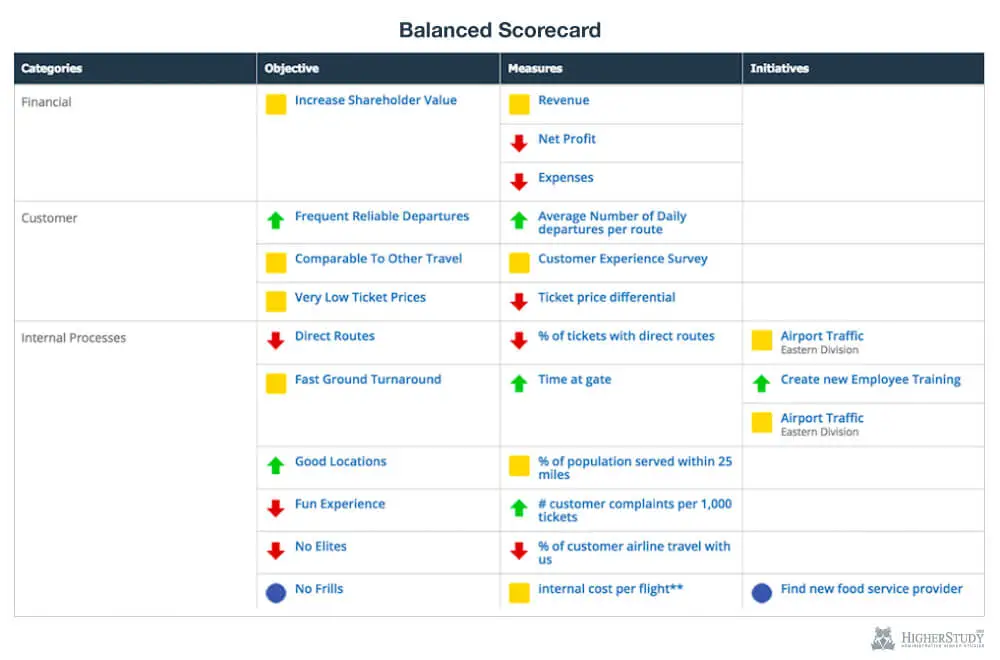
This is just one example of the many diagrams. It provides high-level details into measures and initiatives. Balance Scorecard or this strategic management model shows the status of each objective, measure, and initiative. Here green indicates planned, whereas yellow and red indicate the degrees of trouble.
02. Strategy Map:
A strategy map is another strategic management model. It is a visual tool design to communicate a strategic plan and accomplish high-level organizational goals clearly. Strategy mapping is a main part of the Balanced Scorecard, although it is one more strategic management model. And offers a brilliant way to communicate the high-level data across of organization in a simply-edible format.
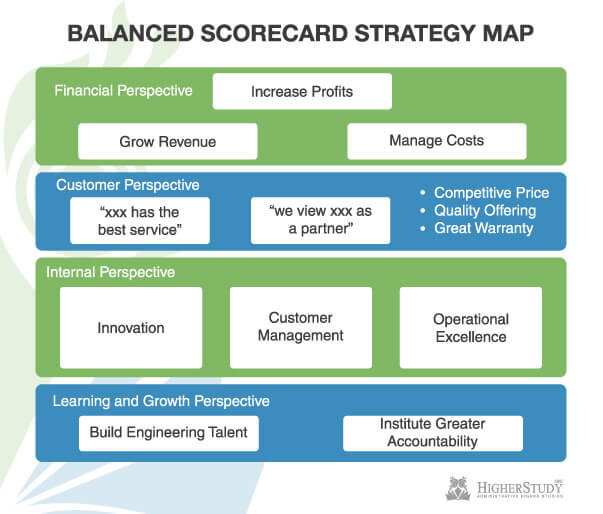
A strategy map offers a host of benefits:
- It unifies all goals into a single strategy.
- It provides an easy, simple, visual representation that is clearly referred back to.
- While accomplishing tasks and measures, it gives every employee a clear goal to keep in mind.
- It helps to identify your key goals.
- A strategy map helps you see how your objectives affect others.
- It allows you to understand better which elements of your strategy need work.
03. Value Chain Analysis:
Value Chain Analysis has two types of activities. One primary activity and other supportive activities. Such as:-
- Primary Activities
- Inbound Logistics
- Operation
- Outbound Logistic
- Marketing
- Service
- Supportive Activities
- Firm’s infrastructure
- Human resource management
- Technological development
- Procurement of resources, finance, inventory, etc.
You can read detail about the Value Chain Analysis Model.
04. SWOT Analysis/SWOT Matrix:
A SWOT matrix is our third strategic management model. SWOT is an acronym for strength, weakness, opportunity, and threat. Strength and weakness are measured as internal issues. Whereas opportunity and threat are measured as the external issues.
Below is an example SWOT matrix from the Queensland, Australia, government:
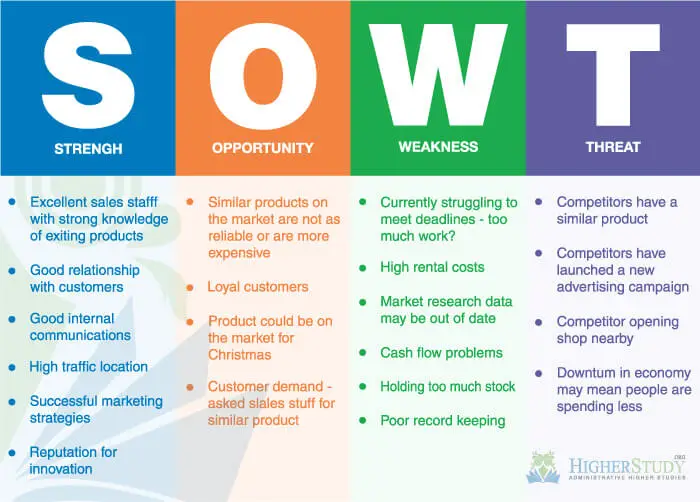
A SWOT matrix helps an organization detect where they’re doing fine and what zones they can develop. You can read more about the Meaning of SWOT Analysis and Steps of SWOT Analysis.
05. PEST/PESTEL Model:
The PEST is an acronym for “political, economic, sociocultural, and technological” like SWOT analysis. Each of these aspects is used to look at a business environment and define what could touch an organization’s health. The PEST of the strategic management model is often used in conjunction with a SWOT analysis’s external factors.
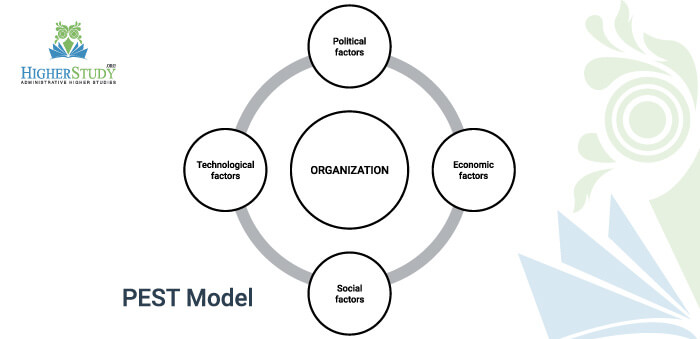
The PEST model adds a few extra letters as like PESTEL (or PESTLE) considers “environmental” and “legal” factors. STEEPLED is an additional variation, which stands for “sociocultural, technological economic, environmental, political, legal, education, and demographics.” Read more about the PEST or PESTLE Model or PESTLED Model.
06. Gap Planning:
Gap planning is also called “the Strategic-Planning Gap,” “Need Assessment,” or “Need-Gap Analysis” in the strategic management model. It is applied to compare where an organization exists, where it expects to be, and how to solve the gap between. It is mainly used to pinpoint precise internal shortages.
In gap planning examination, investigators may also hear about a “shift chart” or “change agenda.” These are akin to gap planning, as they both consider the difference between where the organization has existed and where it expects to be along numerous axes. From there, its planning procedure is about how to ‘close the gap.’
There is mentioned an example of gap planning of strategic management model the difference between the desired and projected sales of a mock company:
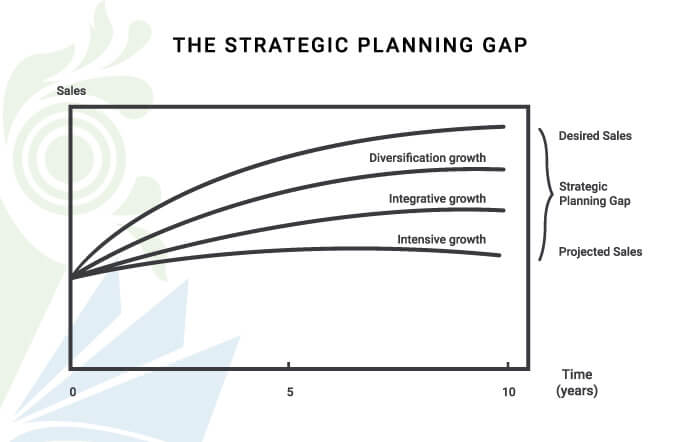
07. Red-Blue Ocean Strategy:
Red-Blue Ocean Strategy is a strategic management model. It originated in the book “Blue Ocean Strategy” in 2004 and was written by W. Chan Kim and Renée Mauborgne, professors at INSEAD (European Institute of Business Administration).
Behind the concept of Blue Ocean Strategy is the developing “uncontested market space” (Blue Ocean) instead of market space. It is either saturated or developed (Red Ocean). If the organization can build a blue ocean, it can mean a gigantic value enhancement for its business, employees, and buyers.
Below is a humble evaluation chart from the Blue Ocean Strategy webpage. It will help to understand if anybody works in a blue ocean or a red ocean:
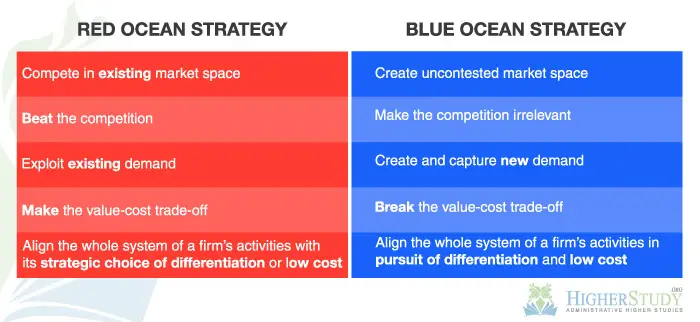
08. Porter’s Five Forces Model:
Michael Porter’s Five Forces Model was an older strategic management model in 1979. Porter’s 5 forces model are:
- The threat of entry
- The threat of substitute products or services
- The bargaining power of customers
- The bargaining power of suppliers
- The competitive rivalry among existing firms
The number of pressure on each of these porter’s 5 forces can help determine how future outlets will influence the upcoming business.
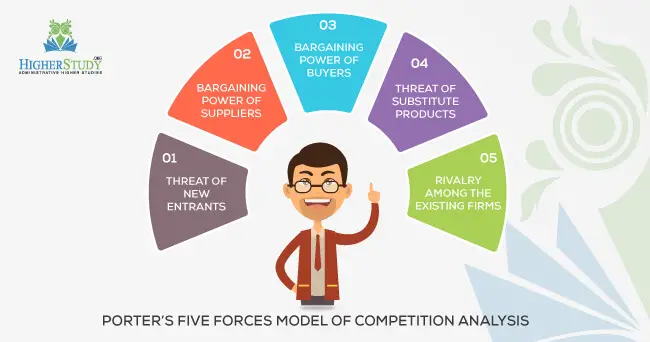
Read more: Porter’s Five Forces Model of Competition Analysis
09. Thompson and Strickland’s 7 Factors Model:
Porter’s Five Forces Model has some drawbacks to overcome; Thompson and Strickland identified the seven factors in the strategic management model. Such as:-
- Industry’s dominant economic features
- Main sources of competitive pressure and the strengths of the competitive forces
- Driving forces
- The market position of the rival companies
- Competitor’s strategic moves
- Industry’s key success factors
- Industry’s overall attractiveness and profitability prospects
Read detail: Thompson and Strickland’s 7 Factors Model
10. VRIO Framework:
The VRIO framework of the strategic management model is an acronym for “value, rarity, imitability, organization.” This model relates more to the vision statement than the overall strategy.
There are mentioned the complements of the VRIO framework. Such as:-
- Value: Are you able to exploit an opportunity or neutralize an outside threat using a particular resource?
- Rarity: Is there a great deal of competition in your market, or do only a few companies control the resource referred to above?
- Imitability: Is your organization’s product or service easily imitated, or would it be difficult for another organization to do so?
- Organization: Is your company organized enough to be able to exploit your product or resource?
Once you answer these four questions, you’ll be able to formulate a more precise vision statement to help carry you through all the additional strategic elements in your plan.
11. Andrew’s Model:
Kenneth Andrews formulated a strategic management model in 1965 called Andrew’s Model. This model comprises the choice of a strategy but ignores control and implementation. In 1971, Kenneth Andrews developed a complete model that encompassed implementation, but it still ignores a strategic evaluation and control.
12. Glueck’s Model:
William F. Glueck formulated several strategic management models based on the decision-making procedure. The phases of this model are given below. For instance:-
- Strategic management elements
- Analysis and diagnosis
- Choice
- Implementation
- Evaluation
13. The Schendel and Hofer Model:
Dan Schendel and Charles Hofer formulated a strategic management model, joining both control and planning functions. It has several steps. Such as:-
- Goal creation
- Environmental study
- Strategy design
- Evaluation of strategy
- Implementation of strategy
- Strategic control
According to Dan Schendel and Charles Hofer, the strategic management model’s formulation share consists of a minimum of three sub-processes. Such as:-
- Environmental analysis
- Resources analysis
- Value analysis
Resource analysis and value analyses are not particularly shown but are well-thought-out to be involved in other things.
14. Korey’s Model:
The founder and President Canadian School of Management; and modern theorist Jerzy Korey-Krzeczowski have recommended an integrated strategic management model. Jerzy Korey-Krzeczowski’s model has three phases. Such as:-
- Preliminary phase
- Strategic planning phase
- Strategic management phase.
Additionally, Jerzy Korey-Krzeczowski says here has at least four continuous sub-processes. Such as:-
- Planning study
- Review
- Control
- Feasibility study
The planning is a continuing procedure; consequently, all these sub-procedures are united. They are interrelated with each other, making the fully active strategic management model.
15. Schematic Model:
Mark Kroll, Charles Pringle, and Peter Wright (1994) established this strategic management model. It has five steps. Such as:-
- Analyzing the environmental opportunity and threat
- The internal strengths and weaknesses of an organization
- Establishing the organizational mission and vision
- Strategy construction
- Strategy Implementation
- Strategic Control.
The Schematic model begins with the analysis of environmental opportunity and threat. Environmental factors exaggerate the organization, but the organization can also have an influence on its environment.
Competency Management
Competency management is comprised of three features. Such as:-
- Competence or Competency
- Core Competence or Core Competency
- Distinctive Competence or Distinctive Competency
Read more about the Competency Management Model




great put up, very informative. I wonder why the opposite specialists of this sector don’t understand this. You must continue your writing. I am confident, you have a huge readers’ base already!
This is a great article. Many people or students will be helped from here. Please, continue such activities. Thank you!
Greetings! I know this is kinda off topic however, I’d figured I’d ask. Would you be interested in trading links or maybe guest authoring a blog post or vice-versa? My website covers a lot of the same subjects as yours and I feel we could greatly benefit from each other. If you happen to be interested feel free to shoot me an email. I look forward to hearing from you! Fantastic blog by the way!
For guest posting, you have to contact admin through Contact Page. Here has a limitation to provide information. I think you’re understood. However, thank you so much for your query. Take care.
This is very interesting, You are a very skilled blogger. I’ve joined your RSS feed and look forward to seeking more of your wonderful post. Also, I have shared your site in my social networks!
Hello, its nice post regarding media print, we all understand media is an enormous source of facts.
What’s up to everyone, it’s genuinely a good for me to go to see this website, it consists of helpful Information.
When a person starts to struggle from his own heart, he is a valuable person
Touche. Sound arguments. Keep up the great spirit.
I like the helpful information you provide in your articles. I’ll bookmark your blog and check again here frequently. I am quite certain I will learn lots of new stuff right here! Best of luck for the next!
Admiring the time and effort you put into your site and detailed information you provide. It’s great to come across a blog every once in a while that isn’t the same unwanted rehashed information. Fantastic read! I’ve saved your site and I’m including your RSS feeds to my Google account.
Thank you Mercedes for your comment. Keep in touch with this site to get some more valuable articles.
Good response in exchange of this question with real arguments and describing all regarding that.
Hello colleagues, good article and nice arguments commented here, I am in fact enjoying by these.